
Lying 2 miles (3 km) north of Kilbirnie in North Ayrshire, Glengarnock Castle in Ayrshire was the
seat of the Cunninghams of Glengarnock. It was once a great castle but was abandoned and left to
decay in the 18th century. Glengarnock castle was the fortress controlling the Barony of Glengarnock. In the 12th and 13th centuries, the lands here were the property of the De Morville
family. The Barony of Glengarnock then passed to the Riddels and the Cunninghams. Sir James Cunningham built the Glengarnock Aisle in the Auld Kirk of Kilbirnie in 1597. The Cunninghams of Glengarnock were a cadet branch of the line of the Earls of Glencairn. John Cunningham, son of Sir James Cunningham of Glengarnock was given 1,000 acres called Dunboy in Donegal Ireland in 1608.
Set upon a remote promontary above Glengarnock Water, this very ruined 15thc keep was defended by a deep ditch across the approaches. The rock on which it stands appears to be around one hundred feet in height. There are features that indicate there was a dry moat there with a drawbridge. The castle itself consisted of a quadrilateral tower in a court of smaller buildings that extended from the east side. The facade was 46’ long and 24’ high. A passage, which was 59’ long, lay between the entrance and tower. On each side there lay a range of two storey apartments. The tower itself was 45’ long and 33’ wide and 40’ in height. A circular stair led to the upper floors. Like Kilbirnie Castle, there are no gun ports. Perhaps natural defences proved these unnecessary. There is no account of when this was erected or by whom but it may have been erected by its last Lords the Cunninghame family or by the Ridels who preceded them. Some say that Glengarnock Castle was the ancient castle of Hardyknute, which is just as well known as a famous battle, the Battle of Largs. It had been abandoned by the 18thc, and used as a stone quarry. The north wall of the castle was destroyed in January of 1839 by storms., but was consolidated in 1841.
Mary Queen of Scots inevitably visited the castle, in 1563.
Floor Plan
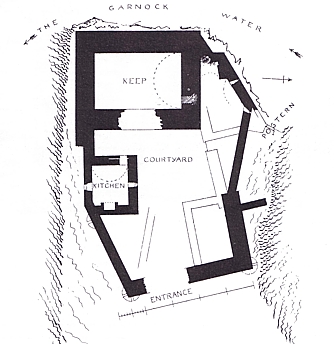
Drawing and actual photograph...from same view
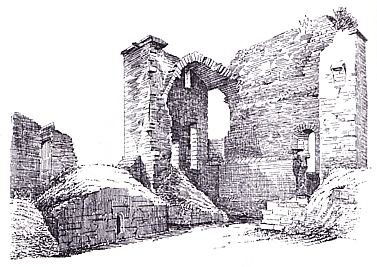
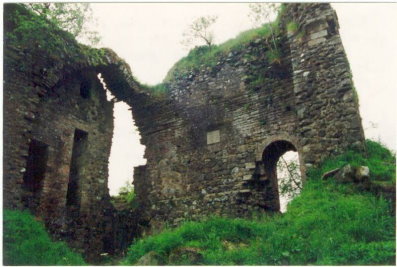
.gif)
from My Glooming Amusements, Poems
by Thomas Macqueen
published 1831
"Glengarnock! the Riddles wha gladden'd thy ba'."
The estate of Glengarnock, in the parish of Kilburnie, Ayrshire, anciently belonged to a branch of the family of Ridel, who were of great antiquity. (By a mistake, this name in the poem is written Riddle.) The manor-place of this estate was Glengarnock Castle, which was placed on a promontory on the banks of the Garnock. The river winded round two sides of this projection, and the only access to the house was at the front, from the northeast, on which side, and at a distance of 200 feet, there was a dry moat, and draw-bridge. There is still a hollow in the surface, which marks out the course of the moat. The house has not been inhabited for a long period, and is now a complete ruin. The ground-plan can still be traced, though with considerable difficulty. From a measurement lately taken it appears that the entrance front was forty-six feet long, and twenty feet hight, with a window on each side of the door. After entereing, there was a passage of fifty-six feet long, and sixteen wide, leading to the main building, which presented a front of forty-four feet in length, and twelve feet higher than the outer walls. The upper story contained only one room, which was thirty-two feet long, and twenty-one wide, within the walls. One window in this room, overlooked the chasm of the river, at a height of sixty feet, and two looked into the front passage. The roof seems to have been flat, and covered with stones. Not withstanding the magnitude of this edifice, it appears to have afforded poor accommodation, and though it must have been reared at great expense, it could not have been a place of great strength, at least under the system of modern warfare; as it is fully commanded from several adjoining heights. The ruins show neither the machicolated battlement, or arrow-slit of ancient defense; nor the embrasures of more modern times. It is, however, without doubt, very ancient; the rude style of architecture, the useless and unskillful waste of material, and the uncomfortable situation all betoken an age in which civilization made little progress. Some have imagined that it was the residence of the De Morville family, the Lords of Cunningham; there being no other ruins in the district which exhibit so great antiquity, and so much decayed grandeur. This is, however, purely fanciful; and is only worthy of being classed with the kindred conceit of its being the residence of Hardyknuta. The ruins present a bold and dignified aspect; and form a very prominent object to the surrounding country; they stand upon the fram of Blackbarn, now part of the estate of William Cochrane, Esquire of Ladyland.
(Dobie, on the Crawford Peerage, Pages 6-7, Edin, 1831)
"All fearless thy Cunningham strode over the heath, to the field o' the Largs."
Ridel, the heiress of Glengarnock, was married to the gallant Hervey Cuninghame, of Kilmaurs, who behaved with distinguished valour at the battle of Largs, in 1263. See, Douglas' Peerage, vol 1, page 632. Galfridus Cuninghame the second son of this marriage, was the ancestor of the Cuninghames of Glengarnock, who held this estate for several centuries.
(Dobie, on the Crawford Peerage, Page 6)
"At the Battle o' Pinkie whar banners did wave, Thy Cunningham fell an' gat nocht but a grave, For his peerless an' patriot seal."
William Cunningham of Glengarnock, was killed at the battle of Pinkie in 1547.
Robertson's Ayrshire Families vol 1, page 310)
"Thy ill-weirded Richard wha faught wi' the Dukes"
Richard Cunninghame, son of Wm. Cunninghame, W. S. (who was the second son of James, first Eisenyard, a son of Craigends) in 1654, married a niece of the celebrated George Herriot, founder of Herriot's Hospital, Edinburgh. By this marriage he is said to have received L12,000, but he must have been a wealthy man before; for he had, some years previous to this, purchased Glengarnock, and was residing in the ancient Castle of the Ridels, and the almost as ancient Cunninghames, who succeeded them. He was very loyal to his King, in the unhappy times of Charles I. by the prevalance of fanatical notions among the people. In 1648, he raised a troop of 100 horse, all armed and paid at his own expense, with which he joined Duke Hamilton, and marched with him to England; where at Preston, on the 20th August, they were defeated, the Duke taken prisoner, and afterwards beheaded, on the 9th March, 1649. Richard was ordained to do penance for this, in the Church of Kilburnie. Mr. Russel the Minister, was not very hard on him; he allowed him to remain in his own seat, and said, "Glengarnock, you were concerned in what is called the wicked engagement; you went into England, in a hostile manner, under Duke Hamilton; you did little good there" To this he replied, he was penitent. Both he and the Minister were sorry hea had done so little for their King. This penance did not hinder him from again raising another troop of 100 horse, and marching with it into England, under Charles II, where at Worcester, they met with a similar fate, in 1651. These services, as some money lent, had no return at the Restoration, in 1660. Richard died in 1678. His Lady, Elizabeth Herriot, died in 1672; both are buried in Glengarnock-aisle in Kilburnie Kirk.
(Robertson's Ayrshire, or Cunninghame Families, page 313)
.gif)
Glengarnock Aisle & Kilbirnie Church
A pre-Reformation church on the site of 6th-century cell dedicated to St Brendan of Clonfert. The nave dates from 1470 and the bell-tower from 1490. Glengarnock aisle added 1597. Crawfurd aisle added in 1642 with unique Renaissance-style carving. Pulpit c.1620
Note the Cunningham Coat of Arms above the windows...
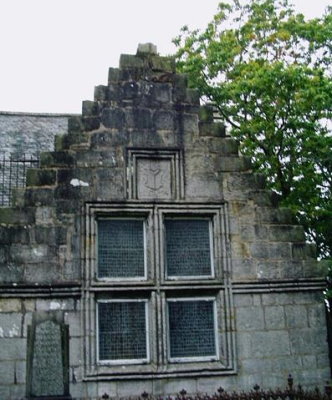
note the Cunningham Coat of Arms, third from right...
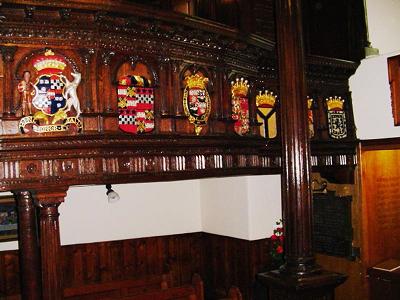
Outside the church there are three carvings to be seen (photos below), two on the south face of the Bell Tower, and one on the south-facing Cunningham, or Glengarnock Aisle. One on the tower is oddly and unsymmetrically placed, as if the builders had taken a stone which had previously been carved and used it to fill a gap. This is the uppermost, immediately under the eaves, to the right of the window, and it bore the impaled Arms of Crawfurd and Barclay, now so weathered as to be almost unrecognisable from ground level. When the tower had its original corbie-stepped gable modernised in 1854, the stone was replaced upside-down for unknown reasons, but this was rectified during the 500th Anniversary restorations. The reason for the impalement of the Arms was the acquisition of the Barclay territory by the purchase of the Glengarnock Barony, into which it had been absorbed. This was in 1677. Lower, at the "intake" where the rising wall was reduced in thickness, directly under the window, the second stone is found; this is carved with the undifferenced Arms of Cunningham of Glencairn. If this stone is original it shows the importance of the Glencairn family in 1490 when the tower was built. Cunningham of Glengarnock castle was the holder of the Barony of that name, and his was a cadet branch of Glencairn. The illustration on the right is taken from Dobies book, and shows the panel under the eaves in its upside-down position.


The third external Coat of Arms is on the gable end of the Cunningham Aisle above the windows. It is still in quite good condition and can be easily read. (photos below) The undifferenced Arms of Glencairn can be seen on an elaborate shield, with the date of the erection of the Aisle, 1597, thirty seven years after the Reformation. In addition to the shield are the initials of James Cunningham, I.C. and of his wife Catherine, K.C. the second daughter of William, seventh Earl of Glencairn.
.gif)
Directions to Glengarnock Castle (ruin).
Take the A78 to Largs and then the A760 to Kilbirnie. After Tescoturn left along Dipple Road and after 1 mile turn left downhill to Blackburn Farm road end. These dramatic ruins are perched on a promontory surrounded on three sides by the deep gorge of the River Garnock. The site was probably occupied by Hugh de Morville, Norman overlord of North Ayrshire in the 12th century.
Access: Open access over a muddy field. Beware of loose stonework and very steep drops to the river.
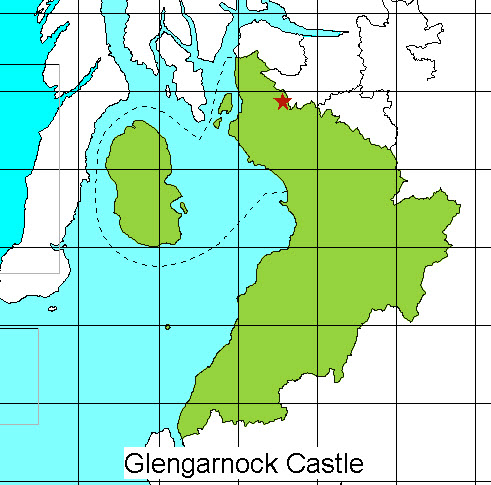
.gif)





Copyright Cunningham Family Website - All Rights Reserved

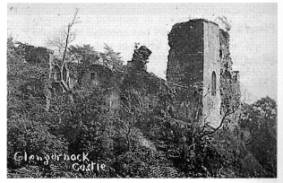



.gif)
.gif)




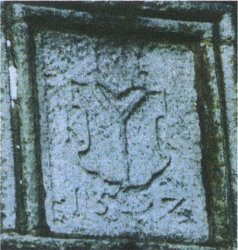
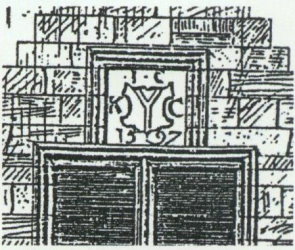
.gif)

.gif)




